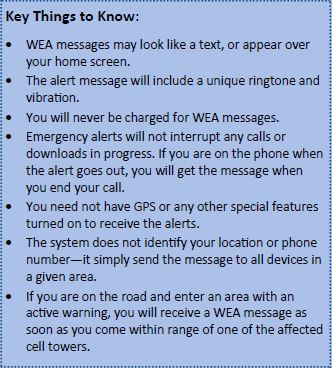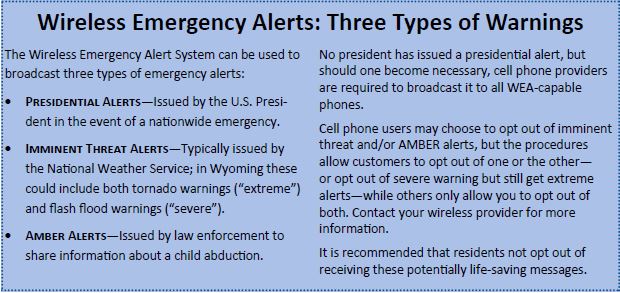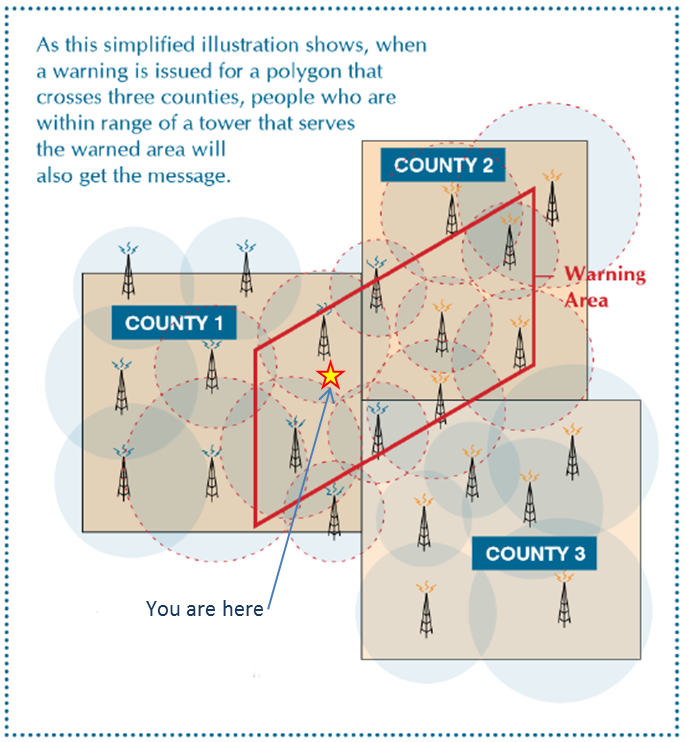
A strong atmospheric river will bring heavy rainfall to California through the holiday week. The heaviest rainfall is expected on Wednesday in the Los Angeles Basin. Flash and urban flooding is possible. A prolonged heavy snowfall is expected in the Sierra Nevada from the atmospheric river, raising concerns for major snow‐load impacts. Travel may be difficult to impossible over the passes. Read More >
 |
Building a Weather-Ready Nation |
What is WEA? | How do they work? | Frequently Asked Questions | Additional Info
Wireless Emergency Alerts (WEA) are emergency messages, usually less than 90 characters, that are sent directly to your phone by authorized government alerting authorities through your mobile carrier. Government partners include local and state public safety agencies, FEMA, the FCC, the Department of Homeland Security, and the National Weather Service.
 |
| Important facts about Wireless Emergency Alerts. |
When an alert is issued by the appropriate authorities, cell towers in the affected areas will pick up this alert. It will then transfer this alert to all phones connected to that cell tower. This system does not track your location, so if your connected to the affected cell tower you may recieve the emergency alert even though you are not in the affected area. There are three types of warnings that will trigger a Wireless Emergency Alert (WEA). They are Presidental Alerts, Imminent Threat Alerts, and Amber Alerts. See the graphic below for more details on each alert.
 |
| See above for what types of alerts or warnings will trigger a Wireless Emergency Alert. |
Still have more questions on how these alerts work, when you will receive them, and where to find more infomation? Please scroll down through this website to find more information. If you still have unanswered questions plese feel free to contact your local National Weather Service Office, local Emergency Management Office, or wireless provider.
| A short video example of what a Wireless Emergency Alert will look like. Click here for the spanish version. |
 |
| In weather emergencies, National Weather Service Meteorologists monitor Radar, Satellite, and other observation data (such as storm reports) to issue life saving hazardous weather warnings. Note: WEA can also be sent by other emergency personell for Presidential Alerts and Amber Alerts. |
 |
| When a warning gets issued that qualifies as a WEA message, cell towers will pick up this message. The alerts are then delivered directly from the cell tower in the warned area to any WEA-capable cell phone recieving its signal from that tower, through a one way broadcast. Note: The system does not rack or locate individual cell phones, it simply broadcasts to all phones within range. This may result in overwarning. |
WEA FAQ: Please click a question to find the answer.
Wireless Emergency Alerts (WEA) are emergency messages sent by authorized government alerting authorities through your mobile carrier. Government partners include local and state public safety agencies, FEMA, the FCC, the Department of Homeland Security, and the National Weather Service.
Alerts received at the right time can help keep you safe during an emergency. With WEA, alerts can be sent to your mobile device when you may be in harm's way, without need to download an app or subscribe to a service.
Alerts you can potential receive include: Extreme Weather Warnings, Local emergencies requiring evacuation or immediate action, AMBER Alerts, and Presidential Alerts during a national emergency.
WEA will look like a text message. The WEA message will typically show the type and time of the alert, any action you should take, and the agency issuing the alert. The message will be no more than 90 characters.
WEA messages include a special tone and vibration, both repeated twice.
The only NWS products that will trigger a WEA message are Tsunami Warnings (more info here), Tornado Warnings, Flash Flood Warnings, Hurricane Warnings, Typhoon Warnings, Dust Storm Warnings, and Extreme Wind Warnings.
Follow any action advised by the emergency message. Seek more details from your favorite TV or radio station, NOAA Weather Radio, news website, desktop application, mobile application, or other trusted source of information.
Yes, if you have a WEA-capable phone and your wireless carrier participates in the program. For information about which mobile devices are WEA-capable and carrier participation, please visit https://www.ctia.org/wea or contact your wireless carrier.
If you travel into a threat area after an alert is first sent, your WEA-capable device will receive the message when you enter the area.
The NWS began participation in the WEA service in late June 2012. Some mobile devices, especially older ones, are not WEA-capable. When you buy a new mobile device, it probably will be able to receive WEA messages. For more details on WEA, including links to your wireless service providers’ unique WEA service information, please visit: www.ctia.org/wea
No, but they are complementary. Local agencies may have asked you to sign up to receive telephone calls, text messages, or emails. Those messages often include specific details about a critical event. WEA are very short messages designed to get your attention in an emergency situation. They may not give all the details you receive from other notification services.
No. This service is offered for free by wireless carriers. WEA messages will not count towards texting limits on your wireless plan.
No. WEA use radio technology to broadcast the alert from cell towers to mobile devices in the area of the threat. Therefore, WEA doesn’t don't know exactly who is tuned in.
No, the alert will be delayed until you finish your call.
You may receive frequent WEA messages during an emergency. Message frequency depends on the number of imminent threats to life or property in your area.
Yes, WEA messages are not affected by network congestion.
 You can opt-out of receiving WEA messages for imminent threats and AMBER alerts, but not for Presidential messages. To opt out, please refer to instructions from your wireless carrier or visit https://www.ctia.org/wea for more information. Some cell phones allow the users to opt-in and opt-out directly on their devices. These devices differentiate the imminent threat alerts into two categories - "Extreme alerts" and "Severe alerts" as shown in the image below. The Extreme alerts from the National Weather Service include warnings for tsunamis, tornadoes, extreme winds, hurricanes and typhoons. The Severe alerts from National Weather Service include warnings for flash floods and dust storms. For example, by keeping Extreme alert selected and de-selecting Severe alert, the user would still be capable of receiving Extreme alerts, but would not receive Severe alerts on their cell phone.
You can opt-out of receiving WEA messages for imminent threats and AMBER alerts, but not for Presidential messages. To opt out, please refer to instructions from your wireless carrier or visit https://www.ctia.org/wea for more information. Some cell phones allow the users to opt-in and opt-out directly on their devices. These devices differentiate the imminent threat alerts into two categories - "Extreme alerts" and "Severe alerts" as shown in the image below. The Extreme alerts from the National Weather Service include warnings for tsunamis, tornadoes, extreme winds, hurricanes and typhoons. The Severe alerts from National Weather Service include warnings for flash floods and dust storms. For example, by keeping Extreme alert selected and de-selecting Severe alert, the user would still be capable of receiving Extreme alerts, but would not receive Severe alerts on their cell phone.
WEA messages are broadcast using radio-like technology from cell towers in, and sometimes around, the actual warning area. Therefore, an alert can reach cell phones outside of the actual warning area depending on the broadcast range of the cell towers which broadcast the alert. This overreach is typically more prevalent in rural areas than in more densely populated cities.
WEA is one of many ways you can receive emergency notifications. Other sources include NOAA Weather Radio, news media coverage, the Emergency Alert System on radio and TV broadcasts, desktop applications, mobile applications, and other alerting methods offered by local and state public safety agencies. Your best use of WEA is to immediately seek additional information about the imminent threat impacting your area.
FEMA has produced Public Service Announcements that demonstrate how wireless alerts save lives. These short videos are available in English and Spanish and can be downloaded and shared with others. And check out real stories of how WEA has saved lives and livelihoods.
 In weather emergencies, warnings can save lives. But traditional warning methods such as television, radio, and outdoor sirens don't reach everyone. Wireless Emergency Alerts allow emergency officials an additional way to send warnings directly to those in affected areas. For even more information see the links below, or feel free to call your local National Weather Service Office, Emergency Management Office, or your wireless provide
In weather emergencies, warnings can save lives. But traditional warning methods such as television, radio, and outdoor sirens don't reach everyone. Wireless Emergency Alerts allow emergency officials an additional way to send warnings directly to those in affected areas. For even more information see the links below, or feel free to call your local National Weather Service Office, Emergency Management Office, or your wireless provide
NWS Riverton WEA Flyer | WEA: Real Stories | WEA: Mobile Weather Warnings
More great information below. Note: These sites, although informative, may not direct to a noaa.gov site.
Information on Emergency Alerts | WEA Consumer Tips | WEA Information for Kids